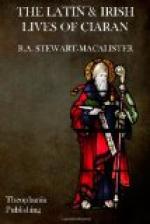The Geographical Names.—Besides “the island of Cathi” (Inis Cathaigh, Scattery) LA refers to “Luim-nich” (Limerick), Kiarraighi (properly Ciarraige, [North] Kerry), and Corco Baiscind (the southern barony of Co. Clare), now spelt “Corcovaskin.”
XXXV. CIARAN IN ISEL (LA, LB, VG)
Cobthach son of Brecan.—This person, who is said in VG to have made over Isel to Ciaran, was probably a local chieftain; but he has escaped the notice of the Annalists. In any case the statement that he made over Isel to Ciaran is so obviously incongruous with the sense of the passage, that it can be safely rejected as an interpolation. Its purpose is to claim for Clonmacnois the possession of the land called Isel, the site of which is no longer known, though it cannot have been far from Clonmacnois. Conn of the Poor, the great and charitable benefactor of Clonmacnois in the early years of the eleventh century, established an almshouse at Isel; and some fifty-six years later, in the year 1087, his son Cormac, then abbot, purchased Isel in perpetuity from the king of Meath.
Parallels.—We have already (incident XXI) seen an example of the rescue of a book from rain; compare also incident XLI. The garment of Finan (CS, 316) and of Cainnech (CS, 371) were preserved from rain, and snow did not injure a book belonging to Abban (CS, 530). The forgetfulness attributed to the saint with regard to his precious volume is a regular feature of this type of incident: it is no doubt meant to honour him, as indicating that the fulfilment of his monastic duties were yet more precious in his eyes. Moling forgot his book when reading by the sea-shore, and though the tide arose and covered it, it remained uninjured (VSH, ii, 191). There are numerous illustrations of the paramount need of attending to guests scattered through the saints’ Lives.




